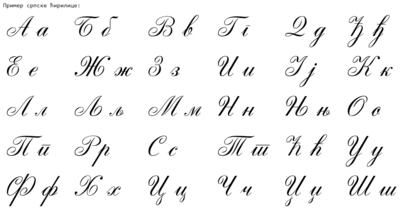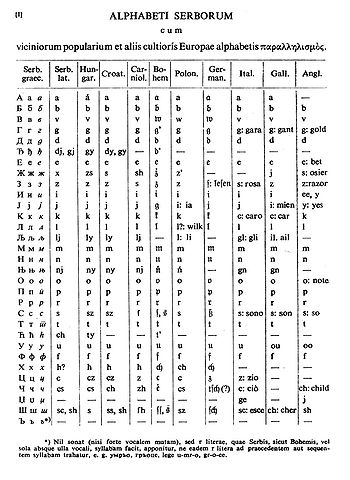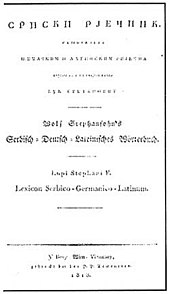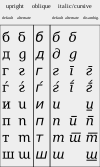Serbian Cyrillic Alpha bet
A request that this article title be changed toVuk's Cyrillic Alpha betisunder discussion.Pleasedo not movethis article until the discussion is closed. |
| Serbian Cyrillic Alpha bet Српска ћирилица | |
|---|---|
 | |
| Script type | |
Time period | 9th century – present |
| Official script | Serbia |
| Languages | Serbian |
| Related scripts | |
Parent systems | Egyptian hieroglyphs[1]
|
Child systems | Macedonian Alpha bet(partly) Montenegrin Cyrillic(partly) |
| ISO 15924 | |
| ISO 15924 | Cyrl(220),Cyrillic |
| Unicode | |
Unicode alias | Cyrillic |
| subset ofCyrillic (U+0400...U+04FF) | |
| South Slavic languagesand dialects |
|---|
TheSerbian Cyrillic Alpha bet(Serbian:Српска ћирилица/Srpska ćirilica,pronounced[sr̩̂pskaːtɕirǐlitsa]) is a variation of theCyrillic scriptused to write theSerbian language,updated in 1818 by the Serbian philologist and linguistVuk Karadžić.It is one of the two Alpha bets used to writemodern standard Serbian,the other beingGaj's Latin Alpha bet.
Karadžić based his Alpha bet on the previousSlavonic-Serbianscript, following the principle of "write as you speak and read as it is written", removing obsolete letters and letters representingiotated vowels,introducing⟨J⟩from theLatin Alpha betinstead, and adding several consonant letters for sounds specific to Serbianphonology.During the same period, linguists led byLjudevit Gajadapted the Latin Alpha bet, in use in western South Slavic areas, using the same principles. As a result of this joint effort, Serbian Cyrillic and Gaj's Latin Alpha bets for Serbian-Croatian have a complete one-to-one congruence, with the LatindigraphsLj, Nj, and Dž counting as single letters.
Karadžić's Cyrillic Alpha bet was officially adopted in thePrincipality of Serbiain 1868, and was in exclusive use in the country up to theinterwar period.Both Alpha bets were official in theKingdom of Yugoslaviaand later in theSocialist Federal Republic of Yugoslavia.Due to the shared cultural area, Gaj's Latin Alpha bet saw a gradual adoption in theSocialist Republic of Serbiasince, and both scripts are used to write modern standard Serbian. InSerbia,Cyrillic is seen as being more traditional, and has the official status (designated in theconstitutionas the "official script",compared to Latin's status of" script in official use "designated by a lower-level act, for national minorities). It is also an official script inBosnia and HerzegovinaandMontenegro,along withGaj's Latin Alpha bet.
Official use[edit]
Serbian Cyrillic is in official use inSerbia,Montenegro,andBosnia and Herzegovina.[2]Although Bosnia "officially accept[s] both Alpha bets",[2]the Latin script is almost always used in theFederation of Bosnia and Herzegovina,[2]whereas Cyrillic is in everyday use inRepublika Srpska.[2][3]TheSerbian language in Croatiais officially recognized as a minority language; however, the use of Cyrillic in bilingual signs has sparkedprotests and vandalism.
Serbian Cyrillic is an important symbol of Serbian identity.[4]In Serbia, official documents are printed in Cyrillic only[5]even though, according to a 2014 survey, 47% of the Serbian population write in theLatin Alpha betwhereas 36% write in Cyrillic.[6]
Modern Alpha bet[edit]


The following table provides the upper and lower case forms of the Serbian Cyrillic Alpha bet, along with the equivalent forms in theSerbian Latin Alpha betand theInternational Phonetic Alphabet(IPA) value for each letter. The letters do not have names, andconsonantsare normally pronounced as such when spelling is necessary (or followed by a shortschwa,e.g. /fə/).:
|
|
Summary tables
| A | a | B | b | C | c | Č | č | Ć | ć | D | d | Dž | dž | Đ | đ | E | e | F | f | G | g | H | h | I | i | J | j | K | k |
| А | а | Б | б | Ц | ц | Ч | ч | Ћ | ћ | Д | д | Џ | џ | Ђ | ђ | Е | е | Ф | ф | Г | г | Х | х | И | и | Ј | ј | К | к |
| L | l | Lj | lj | M | m | N | n | Nj | nj | O | o | P | p | R | r | S | s | Š | š | T | t | U | u | V | v | Z | z | Ž | ž |
| Л | л | Љ | љ | М | м | Н | н | Њ | њ | О | о | П | п | Р | р | С | с | Ш | ш | Т | т | У | у | В | в | З | з | Ж | ж |
| А | а | Б | б | В | в | Г | г | Д | д | Ђ | ђ | Е | е | Ж | ж | З | з | И | и | Ј | ј | К | к | Л | л | Љ | љ | М | м |
| A | a | B | b | V | v | G | g | D | d | Đ | đ | E | e | Ž | ž | Z | z | I | i | J | j | K | k | L | l | Lj | lj | M | m |
| Н | н | Њ | њ | О | о | П | п | Р | р | С | с | Т | т | Ћ | ћ | У | у | Ф | ф | Х | х | Ц | ц | Ч | ч | Џ | џ | Ш | ш |
| N | n | Nj | nj | O | o | P | p | R | r | S | s | T | t | Ć | ć | U | u | F | f | H | h | C | c | Č | č | Dž | dž | Š | š |
Early history[edit]

Early Cyrillic[edit]
According to tradition, Glagolitic was invented by theByzantine Christianmissionaries and brothersSaints Cyril and Methodiusin the 860s, amid theChristianization of the Slavs.Glagolitic Alpha betappears to be older, predating the introduction of Christianity, only formalized by Cyril and expanded to cover non-Greek sounds. The Glagolitic Alpha bet was gradually superseded in later centuries by the Cyrillic script, developed around by Cyril's disciples, perhaps at thePreslav Literary Schoolat the end of the 9th century.[7]
The earliest form of Cyrillic was theustav,based on Greek uncial script, augmented byligaturesand letters from theGlagolitic Alpha betfor consonants not found in Greek. There was no distinction between capital and lowercase letters. The standard language was based on the Slavic dialect ofThessaloniki.[7]
Medieval Serbian Cyrillic[edit]
Part of the Serbian literary heritage of the Middle Ages are works such asMiroslav Gospel,Vukan Gospels,St. Sava's Nomocanon,Dušan's Code,Munich Serbian Psalter,and others. The first printed book in Serbian was theCetinje Octoechos(1494).
Karadžić's reform[edit]

Vuk Stefanović KaradžićfledSerbiaduring theSerbian Revolutionin 1813, to Vienna. There he metJernej Kopitar,a linguist with interest in slavistics. Kopitar andSava Mrkaljhelped Vuk to reform Serbian and its orthography. He finalized the Alpha bet in 1818 with theSerbian Dictionary.
Karadžić reformed standard Serbian and standardised the Serbian Cyrillic Alpha bet by following strictphonemicprinciples on theJohann Christoph Adelung' model andJan Hus'Czech Alpha bet.Karadžić's reforms of standard Serbian modernised it and distanced it from Serbian and RussianChurch Slavonic,instead bringing it closer to common folk speech, specifically, to the dialect of EasternHerzegovinawhich he spoke. Karadžić was, together withĐuro Daničić,the main Serbian signatory to theVienna Literary Agreementof 1850 which, encouraged byAustrianauthorities, laid the foundation for Serbian, various forms of which are used by Serbs inSerbia,Montenegro,Bosnia and HerzegovinaandCroatiatoday. Karadžić also translated theNew Testamentinto Serbian, which was published in 1868.
He wrote several books;Mala prostonarodna slaveno-serbska pesnaricaandPismenica serbskoga jezikain 1814, and two more in 1815 and 1818, all with the Alpha bet still in progress. In his letters from 1815–1818 he used: Ю, Я, Ы and Ѳ. In his 1815 song book he dropped the Ѣ.[8]
The Alpha bet was officially adopted in 1868, four years after his death.[9]
From the Old Slavic script Vuk retained these 24 letters:

| А а | Бб | В в | Г г | Д д | Е е | Ж ж | З з |
| И и | К к | Л л | М м | Н н | О о | П п | Р р |
| С с | Т т | У у | Ф ф | Х х | Ц ц | Ч ч | Ш ш |
He added one Latin letter:
| Ј ј |
And 5 new ones:
| Ђ ђ | Љ љ | Њ њ | Ћ ћ | Џ џ |
He removed:
| Ѥ ѥ(је) | Ѣ, ѣ(јат) | І ї(и) | Ѵ ѵ(и) | Оу оу(у) | Ѡ ѡ(о) | Ѧ ѧ(мали јус) | Ѫ ѫ(велики јус) | Ы ы(јери, тврдо и) | |
| Ю ю(ју) | Ѿ ѿ(от) | Ѳ ѳ(т) | Ѕ ѕ(дз) | Щ щ(шт) | Ѯ ѯ(кс) | Ѱ ѱ(пс) | Ъ ъ(тврди полуглас) | Ь ь(меки полуглас) | Я я(ја) |
Modern history[edit]
Austria-Hungary[edit]

Orders issued on the 3 and 13 October 1914 banned the use of Serbian Cyrillic in theKingdom of Croatia-Slavonia,limiting it for use in religious instruction. A decree was passed on January 3, 1915, that banned Serbian Cyrillic completely from public use. An imperial order in October 25, 1915, banned the use of Serbian Cyrillic in theCondominium of Bosnia and Herzegovina,except "within the scope ofSerbian Orthodox Churchauthorities ".[10][11]
World War II[edit]
In 1941, theNazi puppetIndependent State of Croatiabanned the use of Cyrillic,[12]having regulated it on 25 April 1941,[13]and in June 1941 began eliminating "Eastern"(Serbian) words from Croatian, and shut down Serbian schools.[14][15]
The Serbian Cyrillic Alpha bet was used as a basis for theMacedonian Alpha betwith the work ofKrste MisirkovandVenko Markovski.
Yugoslavia[edit]
The Serbian Cyrillic script was one of the two official scripts used to writeSerbo-CroatianinYugoslaviasince its establishment in 1918, the other beingGaj's Latin Alpha bet(latinica).
Following thebreakup of Yugoslaviain the 1990s, Serbian Cyrillic is no longer used in Croatia on national level, while in Serbia, Bosnia and Herzegovina, and Montenegro it remained an official script.[16]
Contemporary period[edit]
Under theConstitution of Serbiaof 2006, Cyrillic script is the only one in official use.[17]
Special letters[edit]
Theligatures:
| Ђђ | Љљ | Њњ | Ћћ | Џџ |
were developed specially for the Serbian Alpha bet.
- Karadžićbased the letters⟨Љ⟩and⟨Њ⟩on a design bySerblinguist,grammarian,philologist,andpoetSava Mrkalj,known for his attempt to reform the Serbian language before, combining the letters⟨Л⟩(L) and⟨Н⟩(N) with thesoft sign(Ь).
- Karadžić based⟨Џ⟩on letter "Gea" in theOld Serbian Cyrillic Alpha bet.[citation needed]
- ⟨Ћ⟩was adopted by Karadžić to represent thevoiceless alveolo-palatal affricate(IPA:/tɕ/). The letter was based on, but different in appearance to, the letter Djerv, which is the 12th letter of theGlagolitic Alpha bet;that letter had been used in written Serbian since the 12th century, to represent/ɡʲ/,/dʲ/and/dʑ/.
- Karadžić adopted a design by Serbian poet, prose writer, polyglot, andSerbian OrthodoxbishopLukijan Mušickifor the letter⟨Ђ⟩.It was based on the letter⟨Ћ⟩,as adapted by Karadžić.
- ⟨Ј⟩was adopted from theLatin Alpha bet,apparently in preference to⟨Й⟩.
Differences from other Cyrillic Alpha bets[edit]

See also:


Serbian Cyrillic does not use several letters encountered in other Slavic Cyrillic Alpha bets. It does not use hard sign (ъ) and soft sign (ь), particularly due to a lack of distinction betweeniotatedconsonants and non-iotated consonants, but the aforementioned soft-sign ligatures instead. It does not have Russian/BelarusianЭ,Ukrainian/BelarusianІ,the semi-vowelsЙorЎ,nor the iotated lettersЯ(Russian/Bulgarianya),Є(Ukrainianye),Ї(yi),Ё(Russianyo) orЮ(yu), which are instead written as two separate letters:Ја, Је, Ји, Јо, Ју.Јcan also be used as a semi-vowel, in place ofй.The letterЩis not used. When necessary, it is transliterated as eitherШЧ,ШЋorШТ.
Serbianitalicandcursiveforms of lowercase lettersб,г,д,п,andт(Russian Cyrillic Alpha bet) differ from those used in other Cyrillic Alpha bets:б,г,д,п,andт(Serbian Cyrillic Alpha bet). The regular (upright) shapes are generally standardized among languages and there are no officially recognized variations.[18][19]That presents a challenge inUnicodemodeling, as the glyphs differ only in italic versions, and historically non-italic letters have been used in the same code positions. Serbian professional typography uses fonts specially crafted for the language to overcome the problem, but texts printed from common computers contain East Slavic rather than Serbian italic glyphs. Cyrillic fonts from Adobe,[20]Microsoft (Windows Vista and later) and a few other font houses[citation needed]include the Serbian variations (both regular and italic).
If the underlying font and Web technology provides support, the proper glyphs can be obtained by marking the text with appropriate language codes. Thus, in non-italic mode:
<span lang= "sr" >бгдпт</span>,produces in Serbian language script:бгдпт,same (except for the shape ofб) as<span lang= "ru" >бгдпт</span>,producing in Russian language script:бгдпт
whereas:
<span lang= "sr" style= "font-style: italic" >бгдпт</span>gives in Serbian language script:бгдпт,and<span lang= "ru" style= "font-style: italic" >бгдпт</span>produces in Russian language script:бгдпт.
SinceUnicodeunifies different glyphs in same characters,[21]font support must be present to display the correct variant.
Keyboard layout[edit]
The standard Serbiankeyboard layoutfor personal computers is as follows:
See also[edit]
References[edit]
Citations[edit]
- ^Himelfarb, Elizabeth J. "First Alphabet Found in Egypt", Archaeology 53, Issue 1 (Jan./Feb. 2000): 21.
- ^abcdRonelle Alexander (15 August 2006).Bosnian, Croatian, Serbian, a Grammar: With Sociolinguistic Commentary.Univ of Wisconsin Press. pp. 1–2.ISBN978-0-299-21193-6.
- ^Tomasz Kamusella (15 January 2009).The Politics of Language and Nationalism in Modern Central Europe.Palgrave Macmillan.ISBN978-0-230-55070-4.
In addition, today, neither Bosniaks nor Croats, but only Serbs use Cyrillic in Bosnia.
- ^Entangled Histories of the Balkans: Volume One: National Ideologies and Language Policies.BRILL. 13 June 2013. pp. 414–.ISBN978-90-04-25076-5.
- ^"Ćeranje ćirilice iz Crne Gore".novosti.rs.
- ^"Ivan Klajn: Ćirilica će postati arhaično pismo".B92.net.16 December 2014.
- ^abCubberley, Paul (1996) "The Slavic Alphabets". in Daniels, Peter T., and William Bright, eds. (1996).The World's Writing Systems.Oxford University Press.ISBN0-19-507993-0.
- ^The life and times of Vuk Stefanović Karadžić,p. 387
- ^Vek i po od smrti Vuka Karadžića(in Serbian), Radio-Television of Serbia, 7 February 2014
- ^Andrej Mitrović,Serbia's great war, 1914-1918p.78-79. Purdue University Press, 2007.ISBN1-55753-477-2,ISBN978-1-55753-477-4
- ^Ana S. Trbovich (2008).A Legal Geography of Yugoslavia's Disintegration.Oxford University Press. p. 102.ISBN9780195333435.
- ^Sabrina P. Ramet(2006).The Three Yugoslavias: State-building and Legitimation, 1918-2005.Indiana University Press. pp. 312–.ISBN0-253-34656-8.
- ^Enver Redžić(2005).Bosnia and Herzegovina in the Second World War.Psychology Press. pp. 71–.ISBN978-0-7146-5625-0.
- ^Alex J. Bellamy (2003).The Formation of Croatian National Identity: A Centuries-old Dream.Manchester University Press. pp. 138–.ISBN978-0-7190-6502-6.
- ^David M. Crowe (13 September 2013).Crimes of State Past and Present: Government-Sponsored Atrocities and International Legal Responses.Routledge. pp. 61–.ISBN978-1-317-98682-9.
- ^Yugoslav Survey.Vol. 43. Jugoslavija Publishing House. 2002.Retrieved27 September2013.
- ^Article 10of the Constitution of the Republic of Serbia (English versionArchived2011-03-14 at theWayback Machine)
- ^Peshikan, Mitar; Jerković, Jovan; Pižurica, Mato (1994).Pravopis srpskoga jezika.Beograd: Matica Srpska. p. 42.ISBN86-363-0296-X.
- ^Pravopis na makedonskiot jazik(PDF).Skopje: Institut za makedonski jazik Krste Misirkov. 2017. p. 3.ISBN978-608-220-042-2.
- ^"Adobe Standard Cyrillic Font Specification - Technical Note #5013"(PDF).18 February 1998.Archived(PDF)from the original on 2009-02-06.Retrieved2010-08-19.
- ^"Unicode 8.0.0 ch.02 p.14-15"(PDF).
Sources[edit]
- Ćirković, Sima(2004).The Serbs.Malden: Blackwell Publishing.ISBN9781405142915.
- Isailović, Neven G.; Krstić, Aleksandar R. (2015). "Serbian Language and Cyrillic Script as a Means of Diplomatic Literacy in South Eastern Europe in 15th and 16th Centuries".Literacy Experiences concerning Medieval and Early Modern Transylvania.Cluj-Napoca: George Bariţiu Institute of History. pp. 185–195.
- Ivić, Pavle,ed. (1995).The History of Serbian Culture.Edgware: Porthill Publishers.ISBN9781870732314.
- Samardžić, Radovan;Duškov, Milan, eds. (1993).Serbs in European Civilization.Belgrade: Nova, Serbian Academy of Sciences and Arts, Institute for Balkan Studies.ISBN9788675830153.
- SirDuncan Wilson,The life and times of Vuk Stefanović Karadžić, 1787-1864: literacy, literature and national independence in Serbia,p. 387. Clarendon Press, 1970.Google Books



